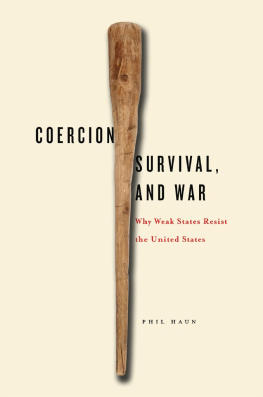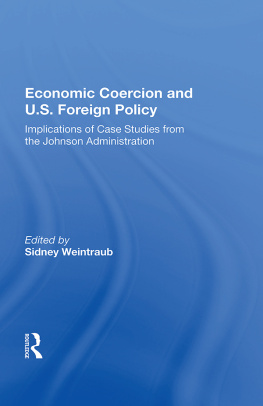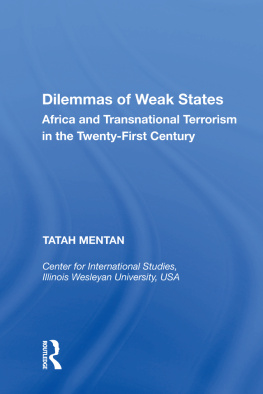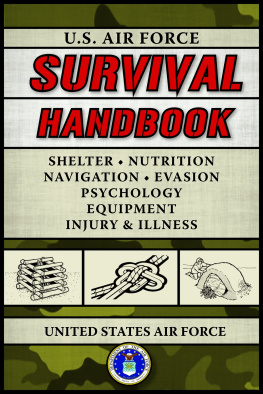Stanford University Press
Stanford, California
2015 by the Board of Trustees of the Leland Stanford Junior University.
All rights reserved.
No part of this book may be reproduced or transmitted in any form or by any means, electronic or mechanical, including photocopying and recording, or in any information storage or retrieval system without the prior written permission of Stanford University Press.
The views expressed in this book are those of the author and do not reflect the views of the Department of Defense or any of its components.
Printed in the United States of America on acid-free, archival-quality paper
Library of Congress Cataloging-in-Publication Data
Haun, Phil M., author.
Coercion, survival, and war : why weak states resist the United States / Phil Haun.
pages cm
Includes bibliographical references and index.
ISBN 978-0-8047-9283-7 (cloth : alk. paper)
1. Asymmetric warfareUnited StatesCase studies. 2. Asymmetric warfareCase studies. 3. United StatesMilitary policyCase studies. 4. United StatesForeign relationsCase studies. I. Title.
U163.H39 2015
355.4'2dc23
2014036166
ISBN 978-0-8047-9507-4 (electronic)
Typeset by Thompson Type in 10/14 Minion
Coercion, Survival, and War
WHY WEAK STATES RESIST THE UNITED STATES
Phil Haun
Stanford Security Studies
An Imprint of Stanford University Press
Stanford, California
To Bonnie for filling my life with such joy
CONTENTS
TABLES, FIGURES, AND MAPS
Tables
Figures
Maps
ACKNOWLEDGMENTS
My journey to answer why the United States fails to coerce weak states commenced in the spring of 1999 when, as an A-10 pilot, I dodged missiles attempting to locate, identify, and destroy Serbian armor. No one up the chain of command could explain how NATOs air strikes would convince Slobodan Milosevic to cede Kosovo. Subsequently, at the School of Advanced Air Power Studies, I studied with Stephen Chiabotti, Forrest Morgan, David Mets, Hal Winton, Rich Muller, Ev Dolman, Jim Corum, Richard Andres, and Tom Ehrhard, who helped me understand how military force could be applied to achieve political outcomes. Many years later at the Security Studies Program at MIT I discovered a group of intellectuals led by Barry Posen, who refused to cut corners in the quest for knowledge or employ methodological gimmicks in the search for truth. I am indebted to Owen Cote, Ken Oye, Robert Art, Roger Petersen, Richard Samuels, Stephen Van Evera, Harvey Sapolsky, Taylor Fravel, Fotini Christia, David Singer, Gabe Lenz, Cindy Williams, Jim Walsh, and Vipin Narang and to my cohort and colleagues Josh Shifrinson, Tara Maller, Austin Long, Caitlin Talmadge, Paul Staniland, Keren Fraiman, Brendan Green, Jon Lindsay, Andrew Radin, Peter Krause, Dan Altman, Will Norris, Nathan Black, Kentaro Maeda, Rachel Wellhausen, Stephanie Kaplan, Sameer Lalwani, Gautam Mukunda, Ben Friedman, Kelly Grieco, Chris Clary, Miranda Priebe, and Jill Hazelton. I thank Barbara Geddes, Ken Schultz, and Todd Sechser for providing me access to their databases and Andrew Bennett, Bob Pape, and Robert Powell for their advice. I especially thank an unnamed reviewer for his or her ruthless feedback. I thank my colleagues at the U.S. Naval War College, especially John Maurer, Colin Jackson, Josh Rovner, Brad Lee, Wick Murray, Scott Douglas, Tim Schultz, Tim Hoyt, Sally Paine, Charlie Edel, Tom Mahnken, David Kaiser, Karl Walling, Dex Wilson, David Brown, Bob Flynn, Mike Vlahos, Toshi Yoshihara, and Nick Saradakis. I thank Fairchild Republic for making an aircraft to survive missile strikes, God for watching over me, and my family for making it all worthwhile. Finally this book is dedicated to Bonnie, who has been with me through it all. Thank you for your talent, patience, and sacrifice to bring this book into reality.
INTRODUCTION
ON AUGUST 2, 1990, ARMORED DIVISIONS of the Iraqi Republican Guard rolled into Kuwait City. The United States responded immediately, convening the UN Security Council, condemning the aggression, and demanding an immediate and unconditional withdrawal. Within days, the Security Council imposed comprehensive sanctions to compel Iraq to reverse its actions. Meanwhile, the U.S. military deployed thousands of aircraft, ships, and troops to the Middle East to deter further aggression. Though economic sanctions soon forced the Iraqi government to begin rationing, its dictator, Saddam Hussein, remained obstinate. In October, President George H. W. Bush ordered a doubling of U.S. deployed forces with the objectives of liberating Kuwait and destroying the Iraqi Army. To garner international and domestic support for war, the administration pressed the Security Council to authorize a coalition of thirty-four nations to use all means necessary to free Kuwait should the Iraqi Army not withdraw by January 15, 1991. In the final days leading up to the deadline, however, the White House feared not that coercion would fail but that it might succeed. Bush had already paid the diplomatic, political, and deployment costs of preparing for war, and his worst-case scenario now had Saddam capitulating. Although such an outcome would have rescued Kuwait, it would also have spared the Republican Guard, guaranteeing Saddam would remain in power and threaten his neighbors in the future.
Fortunately for Bush, coercive diplomacy failed when the January 15 deadline expired and the U.S.-led coalition launched a massive air campaign. Coalition fighters quickly secured air superiority over Kuwait and southern Iraq, while its bombers and cruise missiles simultaneously attacked leadership targets in Baghdad in an effort to paralyze Saddams ability to command and control his military. Undeterred, Saddam ordered Scud missiles to be launched at Israel and Saudi Arabia and, in late January, directed forward elements of his army to advance into Saudi Arabia in an attempt to jump-start his mother of all battles. By early February, coalition air power shifted its effort toward attriting the Iraqi Army in preparation for the land invasion. Saddams strategy had failed both to draw Israel into the conflict and to bait the coalition into an early ground war. His hope of victory faded as the air strikes against Iraqi fielded forces intensified. By mid-February, Iraqi officials broached the possibility of a cease-fire, and Soviet diplomats initiated discussions on the terms of a peace proposal. Fearful that Saddam would now agree to the UN resolutions and deny it the opportunity to destroy the Republican Guard, the United States accelerated the start date for the ground offensive. On the eve of the invasion, Saddam accepted the Soviet-brokered deal, which would have suspended all sanctions against Iraq on the withdrawal of its army from Kuwait, a process for which Iraq would be granted twenty-one days. Bush rejected these conditional terms and instead issued a forty-eight-hour ultimatum for withdrawal. To meet such a deadline would have required the Iraqi Army to abandon its heavy weaponry and prepared defenses. Though willing to withdraw from Kuwait in an orderly fashion, Saddam would not accept the humiliation of a hasty retreat, which would have left Iraqs southern border exposed and his regime vulnerable to domestic unrest. Coercion failed as Saddam chose to face the ground war with a slim chance of victory rather than concede, which would have threatened the survival of the Iraqi state and his regime.
This book is about why the United States chooses to coerce weak states and, as with Iraq in 1991, why coercion so often fails. Since World War II, the United States has been the great power that has most frequently initiated crises with much weaker states. In these asymmetric interstate crises, U.S. leaders have more often than not chosen coercion, which has been met by resistance in half the cases. And, of these unsuccessful efforts, half again have been resolved only by war. Given the overwhelming military advantage enjoyed by the United States, why do weak states so often resist, and why does coercion fail?











